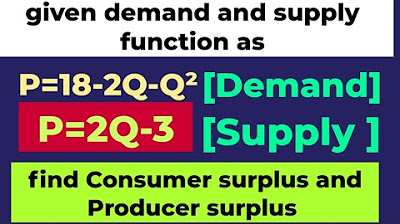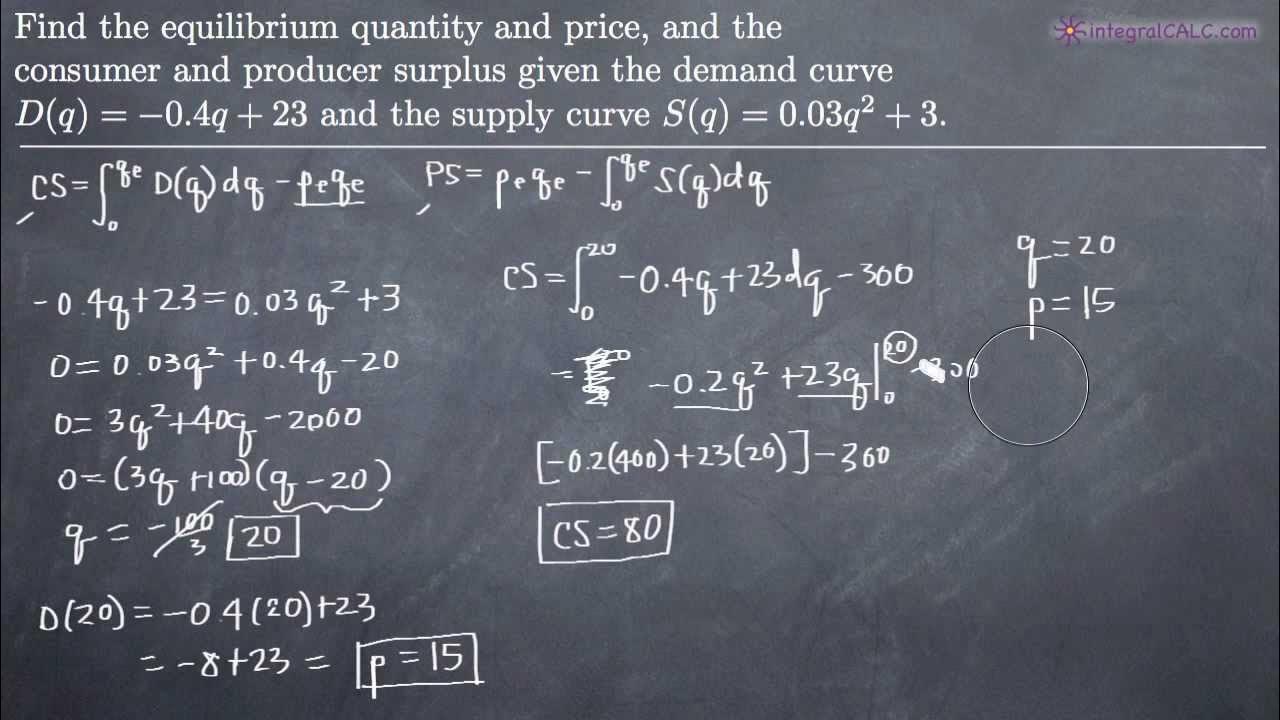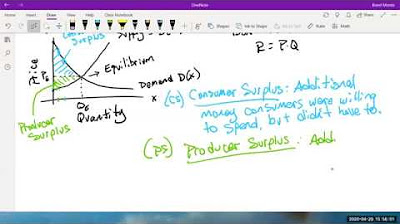How to CALCULATE Consumer Surplus [WITH EXAMPLE] | Think Econ | Microeconomic Concepts
TLDRThis educational video tutorial guides viewers through the process of calculating consumer surplus on a supply and demand graph, both algebraically and geometrically. Starting with sketching the demand and supply curves, the presenter solves for equilibrium price and quantity, finding them to be $30 each. The script then identifies the intersection points of the curves with the price axis, calculating the consumer surplus as the area of a triangle formed by these points, resulting in a consumer surplus of $225. The video promises a future tutorial on producer surplus, encouraging viewers to engage with the content.
Takeaways
- 📈 The video discusses calculating consumer surplus both algebraically and geometrically on a supply and demand graph.
- 📚 The presenter suggests starting by sketching the supply and demand curves before solving for any specific values.
- 🔍 The demand equation given is quantity demanded equals 90 minus 2p, and the supply equation is quantity supplied equals p.
- 🧩 To find equilibrium, the presenter explains setting quantity supplied equal to quantity demanded and solving for the equilibrium price (p*) and quantity (q*).
- 📉 The equilibrium price is found by solving the equation 3p = 90, resulting in p* = 30.
- 📈 The equilibrium quantity is found by substituting p* back into the supply equation, yielding q* = 30.
- 📊 The presenter then calculates the intersection points of the supply and demand curves with the price axis, finding 0 and 45 for the supply and demand curves, respectively.
- 📐 Consumer surplus is the area of the triangle formed between the demand curve, the price axis, and the equilibrium price.
- 🔢 The area of the triangle, representing consumer surplus, is calculated using the formula (1/2) * base * height, resulting in 225 dollars.
- 💡 The unit of consumer surplus is dollars, reflecting the monetary savings to consumers based on their willingness to pay.
- 👍 The video encourages viewers to like, subscribe, and comment with economic concepts or homework questions they'd like to see covered in future videos.
Q & A
What is the main topic of the video?
-The main topic of the video is to calculate the consumer surplus on a supply and demand graph both algebraically and geometrically.
What are the equations provided for demand and supply in the video?
-The demand equation is quantity demanded equals 90 - 2p, and the supply equation is quantity supplied equals p.
How does one find the equilibrium in the video?
-To find the equilibrium, set the quantity demanded equal to the quantity supplied (qs = qd), and solve for the equilibrium price (p*) and quantity (q*).
What is the equilibrium price and quantity calculated in the video?
-The equilibrium price (p*) is 30, and the equilibrium quantity (q*) is also 30.
What are the steps to find the intersection points of the demand and supply curves with the price axis?
-To find the intersection points, set the quantity (q) to zero in the respective demand or supply equation and solve for the price (p).
What are the intersection points of the demand and supply curves with the price axis?
-The supply curve intersects the price axis at p = 0, and the demand curve intersects at p = 45.
How is the consumer surplus represented on the graph?
-The consumer surplus is represented by the area of a triangle formed between the demand curve, the price axis, and the equilibrium price.
What formula is used to calculate the area of the triangle representing consumer surplus?
-The formula used is the area of a triangle equals one half times the base times the height (Area = 1/2 * base * height).
What is the calculated consumer surplus in the video?
-The calculated consumer surplus is 225 dollars.
What are the units for consumer surplus as mentioned in the video?
-The units for consumer surplus are dollars, as it represents the monetary savings for consumers based on their willingness to pay.
What additional topic will be covered in a future video according to the script?
-A future video will cover the topic of producer surplus, which is a related but different concept from consumer surplus.
Outlines
📚 Introduction to Calculating Consumer Surplus
In this educational video, the host introduces the concept of calculating consumer surplus both algebraically and geometrically using a supply and demand graph. The video begins with a generic supply and demand curve sketched on a price and quantity axis, emphasizing the importance of this initial step. The demand equation is given as quantity demanded equals 90 minus 2 times price (qd = 90 - 2p), and the supply equation as quantity supplied equals price (qs = p). The host then proceeds to demonstrate how to find the equilibrium point by setting the quantity demanded equal to the quantity supplied, solving for the equilibrium price (p* = 30) and quantity (q* = 30). The process involves basic algebraic manipulation to find the intersection of the supply and demand curves.
📈 Calculating Consumer Surplus Geometrically
Following the determination of the equilibrium price and quantity, the host explains how to calculate the consumer surplus geometrically. This involves identifying the points where the demand and supply curves intersect the price axis, which are found to be 0 and 45, respectively. The consumer surplus is represented by the area of a triangle formed by these points and the equilibrium point on the graph. The base of the triangle is the equilibrium quantity (30), and the height is the difference between the price where the demand curve intersects the price axis (45) and the equilibrium price (30), which is 15. The area of the triangle, and thus the consumer surplus, is calculated as half the base times the height, resulting in 225 square units, which in this context represents dollars of consumer surplus. The host concludes by summarizing the steps taken to calculate the consumer surplus and hints at a future video on calculating producer surplus.
Mindmap
Keywords
💡Consumer Surplus
💡Supply and Demand Graph
💡Equilibrium
💡Demand Curve
💡Supply Curve
💡Equation
💡Price Axis
💡Quantity Axis
💡Intersection Points
💡Area of a Triangle
💡Willingness to Pay
Highlights
Introduction to calculating consumer surplus algebraically and geometrically on a supply and demand graph.
Recommendation to sketch supply and demand curves before solving for values.
Presentation of generic supply and demand equations: demand (quantity demanded = 90 - 2p) and supply (quantity supplied = p).
Explanation of finding equilibrium by setting quantity demanded equal to quantity supplied.
Solving for equilibrium price (p*) using the equation 3p = 90, resulting in p* = 30.
Calculation of equilibrium quantity (q*) using the supply equation, finding q* = 30.
Identification of additional intersection points needed for consumer surplus calculation: demand curve with the price axis at p = 45.
Method to find intersection of supply curve with the price axis, resulting in p = 0.
Application of the formula for the area of a triangle to calculate consumer surplus.
Determination of the base of the triangle as 30, representing the change from 0 to 30 in quantity.
Calculation of the height of the triangle as 15, the difference between the equilibrium price and the price at the demand curve intersection.
Final calculation of consumer surplus as the area of the triangle, 225 square dollars.
Unit of consumer surplus explained as dollars, reflecting savings based on willingness to pay.
Summary of the steps taken to calculate consumer surplus, emphasizing the equilibrium price and quantity.
Announcement of a future video on producer surplus, following similar lines to the current video.
Invitation for viewers to like, subscribe, and comment on the video for economic concepts or homework questions they'd like covered.
Closing remarks and sign-off for the video.
Transcripts
Browse More Related Video

How to Calculate Producer Surplus and Consumer Surplus from Supply and Demand Equations | Think Econ

consumer surplus and producer surplus

Consumer and Producer Surplus (KristaKingMath)

Consumers' Surplus , Producers' Surplus & Total Surplus from demand & supply Functions #PS

Math 11 - Section 5.1

What is Consumers Surplus and Producer Surplus?
5.0 / 5 (0 votes)
Thanks for rating: